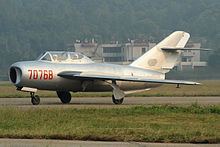Wingspan 9.628 m First flight July 19, 1956 | Engine type Turbojet | |
 | ||
Manufacturer | ||
Il2 1946 shenyang j 5 chinese voice pack
The Shenyang J-5 (Chinese: 歼-5) originally designated Dongfeng-101 - (East Wind-101), and also Type 56 before being designated J-5 in 1964, is a Chinese-built single-seat jet interceptor and fighter aircraft derived from the Soviet Mikoyan-Gurevich MiG-17. The J-5 was exported as the F-5. The aircraft's NATO reporting name is "Fresco".
Contents
- Il2 1946 shenyang j 5 chinese voice pack
- Operational history
- Current operators
- Former operators
- Variants
- Specifications J 5
- References
The MiG-17 was license-built in China, Poland and East Germany into the 1960s. The People's Liberation Army Air Force (PLAAF) obtained a number of Soviet-built MiG-17 Fresco-A day fighters, designated J-5 in the early 1950s. To introduce modern production methods to Chinese industry the PLAAF obtained plans for the MiG-17F Fresco-C day fighter in 1955, along with two completed pattern aircraft, 15 knockdown kits, and parts for ten aircraft. The first Chinese-built MiG-17F, (serialed Zhong 0101), produced by the Shenyang factory, performed its initial flight on 19 July 1956 with test pilot Wu Keming at the controls.
Plans were obtained in 1961 for the MiG-17PF interceptor and production began, as the J-5A (F-5A), shortly afterwards. At this time the Sino-Soviet split occurred, causing much disruption to industrial and technical projects, so the first J-5A did not fly until 1964, when the type was already obsolete. A total of 767 J-5s and J-5As had been built when production ended in 1969.
The Chinese also built a two-seat trainer version of the MiG-17, designated the Chengdu JJ-5 (Jianjiji Jiaolianji - Fighter Trainer - FT-5), from 1968, by combining the two-seat cockpit of the MiG-15UTI, the VK-1A engine of the J-5, and the fuselage of the J-5A. All internal armament was deleted and a single Nudelman-Richter NR-23 23 mm cannon was carried in a ventral pack. Production of the JJ-5 reached 1,061 when production ceased in 1986, with the type exported to a number of countries.
Operational history
The J-5 and JJ-5 saw widespread use by the PLAAF until supplanted by a more capable aircraft the Chengdu J-7.
Current operators
Former operators
Variants
Specifications (J-5)
Data from Gordon,Yefim & Komissarov, Dmitry. Chinese Aircraft. Hikoki Publications. Manchester. 2008. ISBN 978-1-902109-04-6
General characteristics
Performance
Armament
